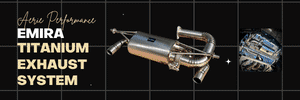I've looked through some of the tire patching threads and didn't feel like it precisely answered my question.
Do I need to replace, or can I patch my tire?
Here's the scenario: My Emira has about 8,000 miles on the odo, Eagle F1 tires. I had the car on the lift for some exhaust work and a guest noticed a nail. It looks to be a small brad nail (like for picture hanging) near the shoulder (maybe an inch or so in) of my Driver's side Rear tire. I haven't noticed any pressure loss, but after taking it to the shop and fiddling with it, there appears to be very light bubbles (maybe). The shop wouldn't repair it since it's "too near the shoulder" and suggested replacing both rear tires - probably $1,400 or so total.
I have taken it on track once in the 18 months I've owned it and may take it on track again next Spring.
Can I patch the tire myself? Would it be safe for daily driving? What about taking it on track?
TIA!
The AI answer was this:
Do I need to replace, or can I patch my tire?
Here's the scenario: My Emira has about 8,000 miles on the odo, Eagle F1 tires. I had the car on the lift for some exhaust work and a guest noticed a nail. It looks to be a small brad nail (like for picture hanging) near the shoulder (maybe an inch or so in) of my Driver's side Rear tire. I haven't noticed any pressure loss, but after taking it to the shop and fiddling with it, there appears to be very light bubbles (maybe). The shop wouldn't repair it since it's "too near the shoulder" and suggested replacing both rear tires - probably $1,400 or so total.
I have taken it on track once in the 18 months I've owned it and may take it on track again next Spring.
Can I patch the tire myself? Would it be safe for daily driving? What about taking it on track?
TIA!
The AI answer was this:
The Goodyear Eagle F1 tires can be safely used on the track after a patch, provided the repair is done correctly and the tire is not subjected to extreme conditions. Several users have reported success with patched Goodyear Eagle F1 tires, including one who used a safety seal plug on a 911 and drove it through multiple track days and speeds exceeding 180 mph without issues. Another user noted that a plug held up well for over 6,000 miles and two years of use, including track driving, before needing replacement. However, some caution is advised: one user mentioned that a shop advised against track use after a plug, suggesting the repair might not be suitable for high-performance driving. The tires do not have a foam barrier, which allows for patching using a "Compound Patch" method, and Goodyear officially approves such repairs. Despite this, the tires are generally considered less ideal for serious track use due to their tendency to degrade quickly under high heat and sustained loads, especially in dry conditions. Therefore, while a properly patched Goodyear Eagle F1 can be safe for track use, it is recommended to monitor tire condition closely and consider switching to a dedicated track tire like the Michelin Sport Cup 2 for more demanding sessions.







